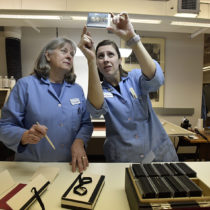Magazine

Bentley Problem Solvers
Whether it’s 150-year-old scrapbooks with decaying binding or collections that might have spent decades in someone’s damp basement, items in the Bentley stacks often need some TLC. Lead conservators Dianna Samuelson and Corinne Robertson explain how the Bentley’s Conservation Lab repairs and preserves items for future generations.
By Robert Havey
Q: What do you do in the Conservation Lab? What’s your mission?
SAMUELSON: We take damaged items from the Bentley’s collections and repair them. We don’t try to make things look new, we stabilize and protect them to make sure they are accessible to researchers now and in the future.
ROBERTSON: We repair newspapers, books, photos—you never know exactly what’s coming in the door. Sometimes it’s some- thing we haven’t done before and we have to think outside the box, but that’s the fun of the job.
SAMUELSON: We’re problem solvers. Every repair is slightly different and might require different tools and techniques.
Q: What kinds of tools do you use in the Conservation Lab?
ROBERTSON: A good number of our tools were originally owned by U-M’s book bindery. We have a board shear, which is like a massive paper cutter; a backing press; and a rounding table. We have two hot stamping machines that we use to stamp 23-karat gold onto the covers of books.
SAMUELSON: If a book’s sewing is broken, we have some old English sewing frames that we use to sew books the same way they were originally sewn. All of this equipment was used by the University when it printed and bound its own textbooks.
Q: What’s the coolest thing you’ve worked on?
SAMUELSON: We worked on a complete set of Michiganensians [yearbooks] for the U-M President’s house. We had to make sure the bindings were repaired in a way that would be aesthetically pleasing on the shelf, but the inside pages had to be strong enough for guests of the president to flip through. We were told people will always pull down the Michiganensian from their graduation year.
ROBERTSON: The astrological globes! We were given these teaching globes from the Detroit Observatory. They aren’t globes of Earth but the of the night sky. They had little stickers on them from when teachers had marked specific points for students to observe. One had gold paintings of astrological signs. They were cool, but in bad shape. There were puncture holes, rusty nails sticking out, the wood was delaminating; it was a hot mess. We had to do a lot to make them usable again.
SAMUELSON: It’s a pleasure to work on things that are 100–150 years old and know that we’re making things sound and usable for another 150 years. It feels like an honor.
